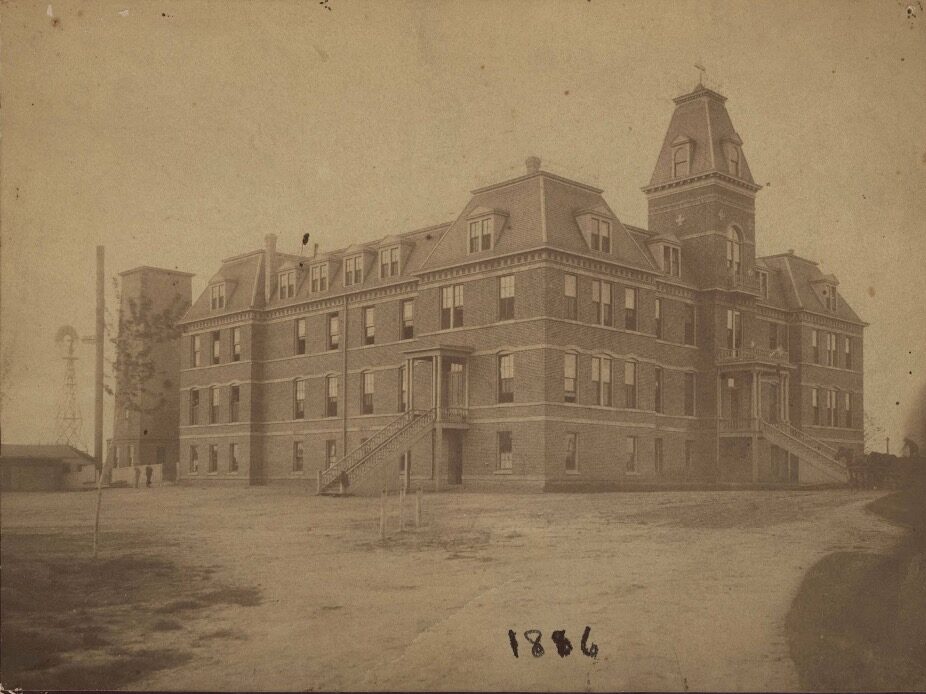With nearly two-dozen new buildings since the turn of the century, the modern St. Thomas campus, which spans two cities, bears little resemblance to the one building Archbishop John Ireland founded the school on in 1885, but as one walks through campus, they can almost see the past two hundred years roll by.
The recent constructions clearly mark a period of growth and expansion for St. Thomas, yet many may not realize that the red-brick of Ireland Hall or the large, smooth kosada stone across the Anderson Student Center are historical markers in the school’s history, and are inspiring the expansion of the campus in more ways than one.
“Originally, the campus was one building. It was actually built to be what the Diocese called an industrial school,” said Anne Kenne, head of special collections and archivist at St. Thomas. “They wanted to bring orphans and kids who got in trouble and teach them a trade.”
When that didn’t work, Kenne said, they closed down the industrial school and repurposed the single building as the College of St. Thomas, a seminary with only 62 students and five faculty.
The first additions to the St. Thomas campus came in the early 20th century with Ireland Hall and Mennith Hall, introducing the classic red-brick buildings still found on North campus today.
At the time, the school was considered to be “in the middle of nowhere,” Kenne said; the campus was surrounded by fields and a lake, Lake Mennith, where part of the East quad is today.
Part of why Lake Mennith went away was because as the city developed around it. “They started putting in storm drains and things like that, which took away a lot of that water from the wetlands, so that took away the water that filled up Lake Mennith,” Kenne explained.
As the university ran into financial straits during the Great Depression and World War I, the university hired the Holy Cross Fathers, who ran the University of Notre Dame, for five years due to their expertise running higher education campuses. During those 5 years, the Collegiate Gothic style that can be found both at the University of St. Thomas and Notre Dame became the architectural style for the campus.
As the 20th century progressed, St. Thomas adopted Collegiate Gothic for its classrooms and administrative buildings, all clad in the iconic kasoda stone and peaked roofs found on buildings such as the Anderson Student Center, Murray-Herrick Administrative building and Aquinas Hall.
“It was designed by a company called Maginnes and Walsh, out of Boston,” Kenne said. “They did a lot of work on the Notre Dame campus and that’s where you first get the idea about having the – what they call Collegiate Gothic look – for the classroom buildings with, with the pale stone on the outside.”
But one building stands out from the rest of the Kasoda stone or red-brick: O’Shaughnessy Education Center.
“OEC shows up in the early 1970s and there’s a different vibe in architecture at that time,” Kenne said.
Built in 1970 by Haarstick, Lundgren & Associates, who also designed U.S. Bank Center and Warren E. Burger Federal Building & United States Courthouse; OEC takes a noticeable turn away from the classic architecture of campus, with its sharp angles and large, smooth, plains of stone, the building is somewhat of an enigma in the university’s stylized history.
As St. Thomas moved into the 21st century, the buildings on campus began to take a more contemporary look, somewhat inspired by a combination of the Brutalism of OEC and the more Gothic style found on the rest of campus.
Large windows began showing up where walls would’ve been. Flynn Hall, constructed in 2004, began this trend, followed by McNeely hall in 2006 and then Tommie North and Tommie East in 2020. Tommies can expect a similar style for the Schoenecker Center being built on South Campus in the next few years.
“I haven’t been back on the campus since the ’80s,” Allen Boyd, a former community member said. “But since being back it’s awesome how much the campus has grown. I’m awestruck.”
Elijah Todd-Walden can be reached at todd5861@stthomas.edu.
Cami Good can be reached at cami.good@stthomas.edu.






